2020 Releases
Release 20.12.0 - 2020-12-14
New
The Google Analytics destination form now provides a button to copy the segment as it is sent to GA, for facilitating creating the audience there.

Javascript loading and event tracking code can now be copied independently.
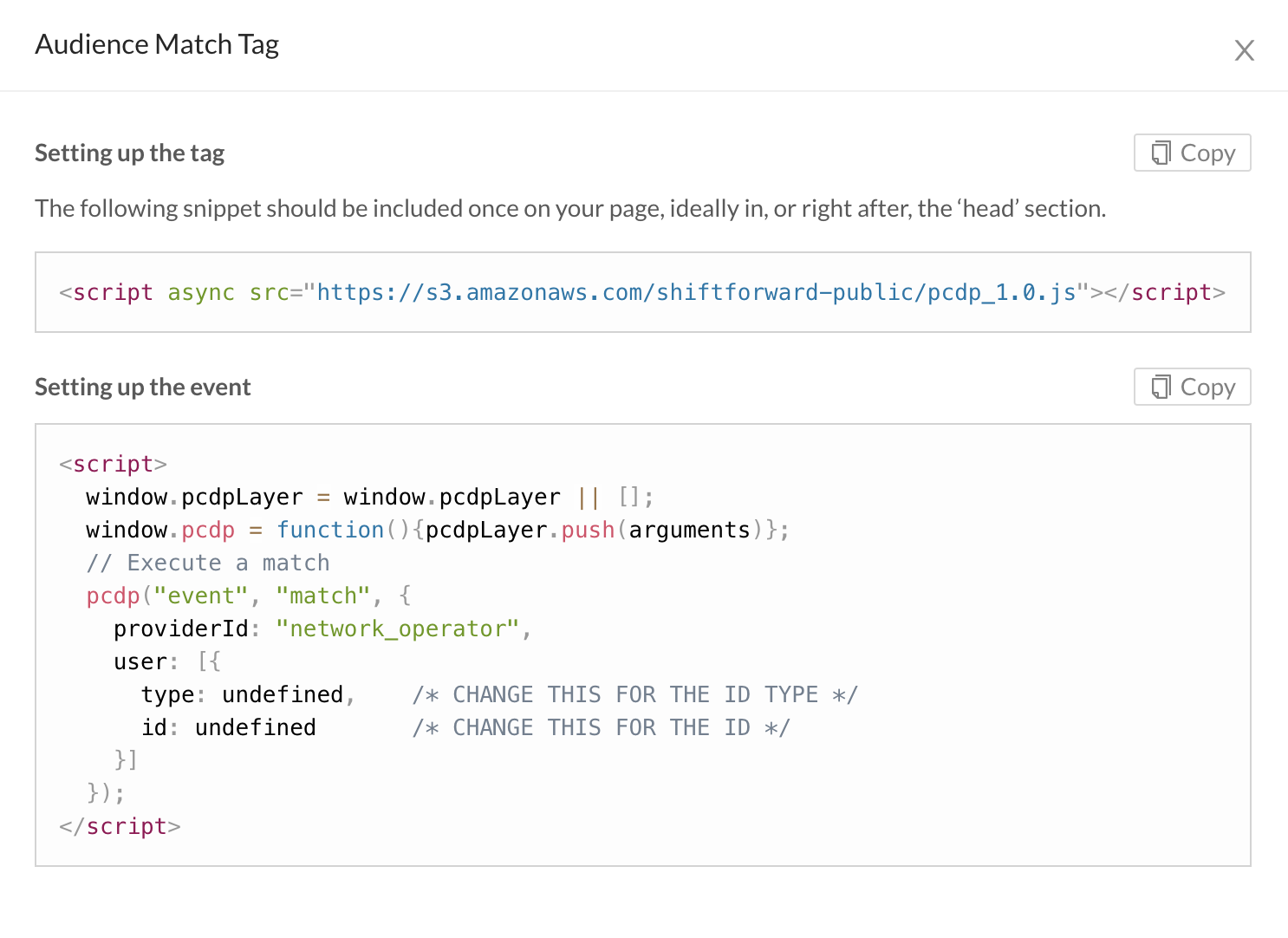
Release 20.11.2 – 2020-11-30
New
The Google Analytics destination now shows activation details, including the destination account and activated segments.
productCustomizationevents now have an attribute to specify which items are being customized.Schemas for
orderPlaceevents have been updated:- Products need a product ID and line item ID, to identify both the product and its variant.
- Tax, subtotal, and shipping cost attributes are now optional, in both the orders and products.
Multiple selections can now be made in a single rule when creating Product Interaction segments. This simplifies the process of creating segments that include multiple brands, sizes, or product categories.
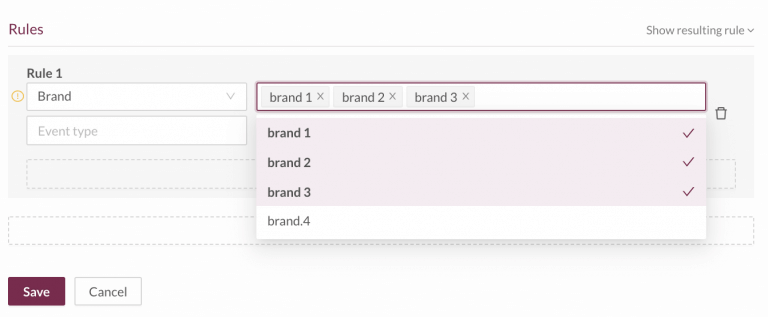
The pre-configured Velocidi segment previously named MVP Customers has been renamed Best Customers. The rules for this segment remain the same. Activations using this segment are unaffected.
Improvements
- Google Analytics activation events are now sent as non-interactive (
'non_interaction': true). - Fixed a bug that reversed the "require activation parameters" option while configuring a destination.
Release 20.11.1 – 2020-11-16
New
We've added
productCustomizationevent type to the list of events capable of generating product-related attributes.productCustomizationevents can be used for segmentation by product interaction.
Users can now segment by custom fields. This is useful when dealing with products that can be customized. Customizations can be anything that varies in a product, such as color, style, trim, etc.
A new retargeting strategy has been introduced for recommending products based exclusively on the products a user has interacted with. The list of products is available in the
recommendations.retargeting.listuser attribute for activation to third-party platforms. For example, it can be sent as a custom dimension to Google Analytics for running retargeting campaigns.
Release 20.11.0 – 2020-10-02
New
- Predictions' scope improved with AppView events. Our machine learning models powering predictive Velocidi segments such as prospecting and retargeting based on "Active Potential Converters" now also take AppView events into account.
- Facebook authentication now supports accounts with +25 linked Ad Accounts.
Improvements
- Fixed an issue in which clients with a large volume of orders would not be able to see them.
- Fixed an issue in which segmenting by product interaction would prevent attribute values with special characters from being shown on the selection dropbox.
Release 20.10.1 – 2020-10-19
New
A new Orders page has been added to the left navigation on all client systems. Found under the 'Collect' section, this page shows a detailed log of order activity from your e-commerce order management system.
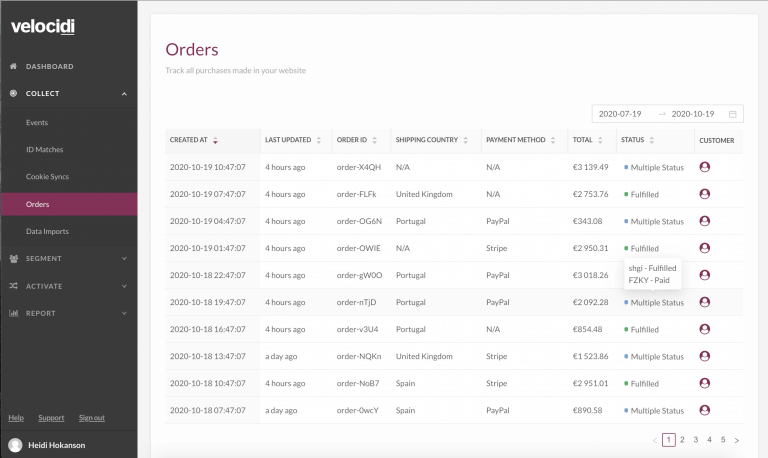
Improvements
- Two default segments, "Prospecting – Active Potential Converters" and "Retention – Next predicted purchase within two weeks", have been updated to improve performance.
- Total purchase values that appear in the main dashboard now reflect purchases made in foreign currencies converted to the system's default currency.
- Fixed a bug causing segments created with the
allTimeoperator to display incorrectly after saving. - Fixed a bug causing
emailViewevents to appear as direct instead of email events.
Release 20.10.0 – 2020-10-06
New
"Customers On Active Buyer Journeys" Predictions – We have extended our predictions models based on likelihood to purchase in the 7 days to also include predictions for likelihood to purchase in the next 1, 2, and 14 days.
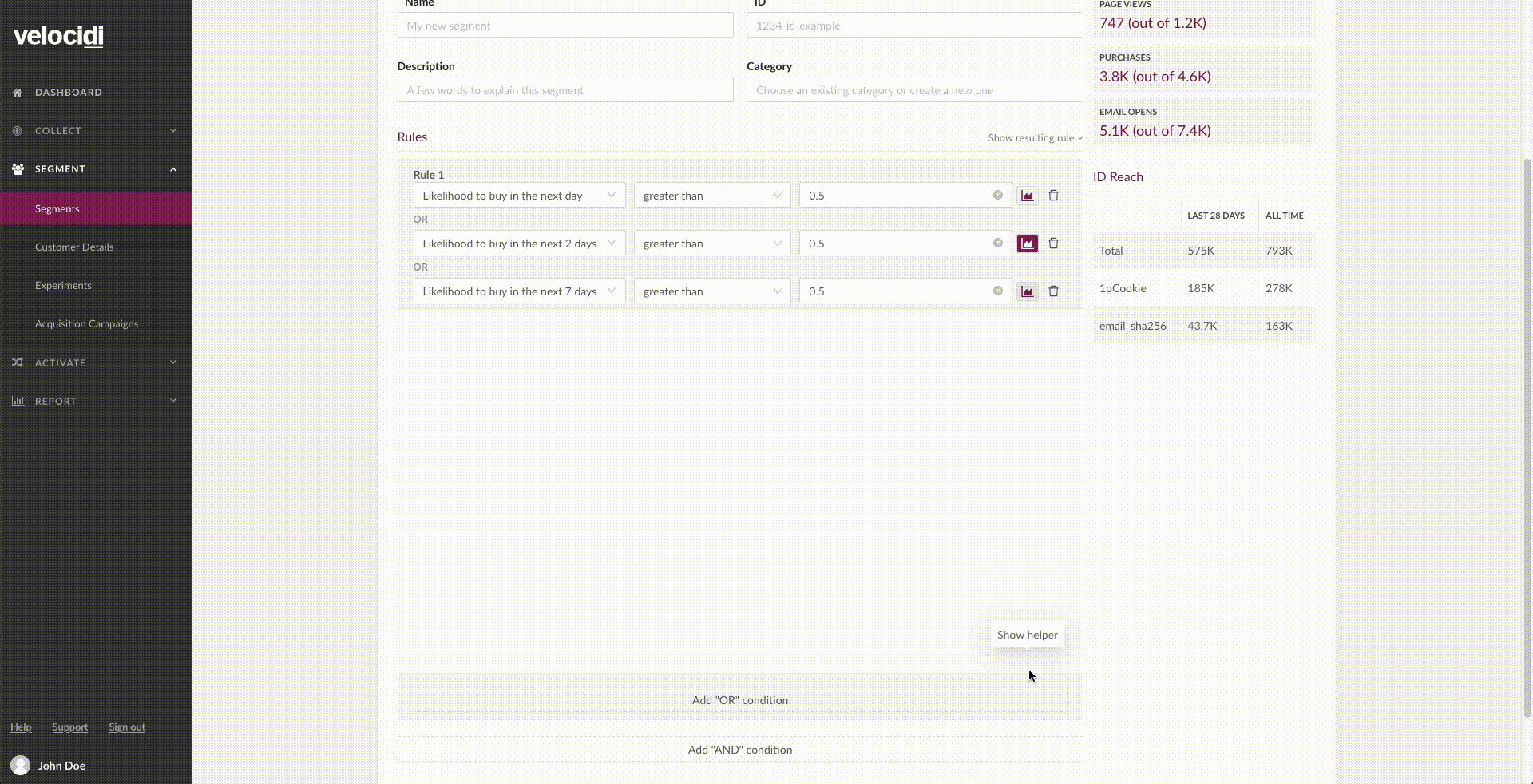
Improvements
- Fixed minor aspects regarding user experience and UI, as well as some infrastructural improvements.
Release 20.9.1 – 2020-09-21
New
Product Interaction Segments – Users can now segment audiences according to the products they interacted with on your online store. The segment builder will be adapted to your product catalog, to reflect the brands, sizes, and product categories in your store. Read more about the use cases for product interaction segments.
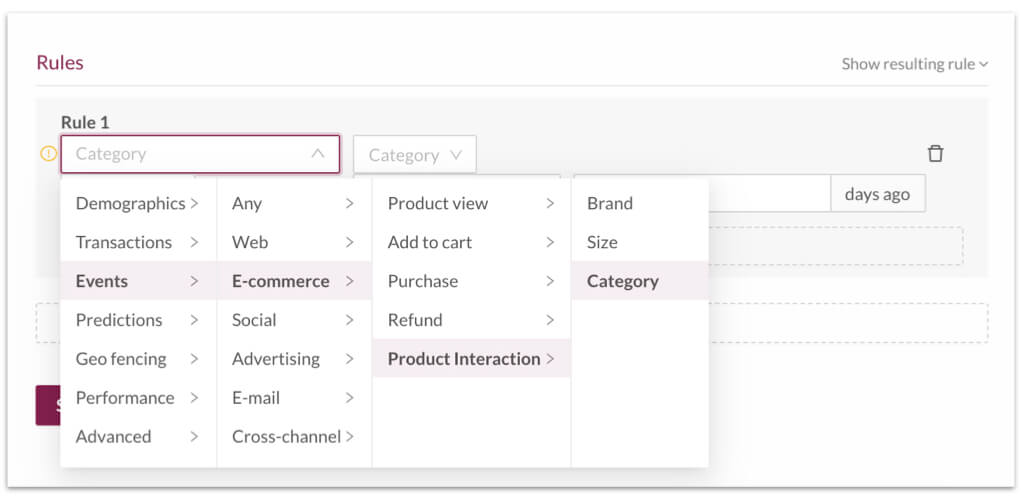
Improvements
- Fixed a bug causing the dashboard to crash when field changes take place while the predictive segment builder graph is open.
- Fixed an inconsistency in the attribution report time frames caused by automatic adjustments to the viewing user's time zone. Report time frames will now be locked to the time zone of the user generating the report.
- Fixed a bug that forced activation requests to ignore cache configurations.
Release 20.9.0 – 2020-09-07
New
- 41 global currencies, including a few cryptocurrencies, are now recognized in the transaction data recorded by the CDP. Visit the list for all currencies currently supported.
Improvements
- Dimension limits for the Google Analytics 360 destination have increased from 20 to 200 match the limit for paid Google 360 accounts.
Release 20.8.1 – 2020-08-24
New
New Custom Destinations have been added to the destination's wizard menu including Criteo, MediaMath, Monetate, Adform, SpotX, IntelliAd, Smartclip, Roq.ad, Video Reach, and AdAudience.
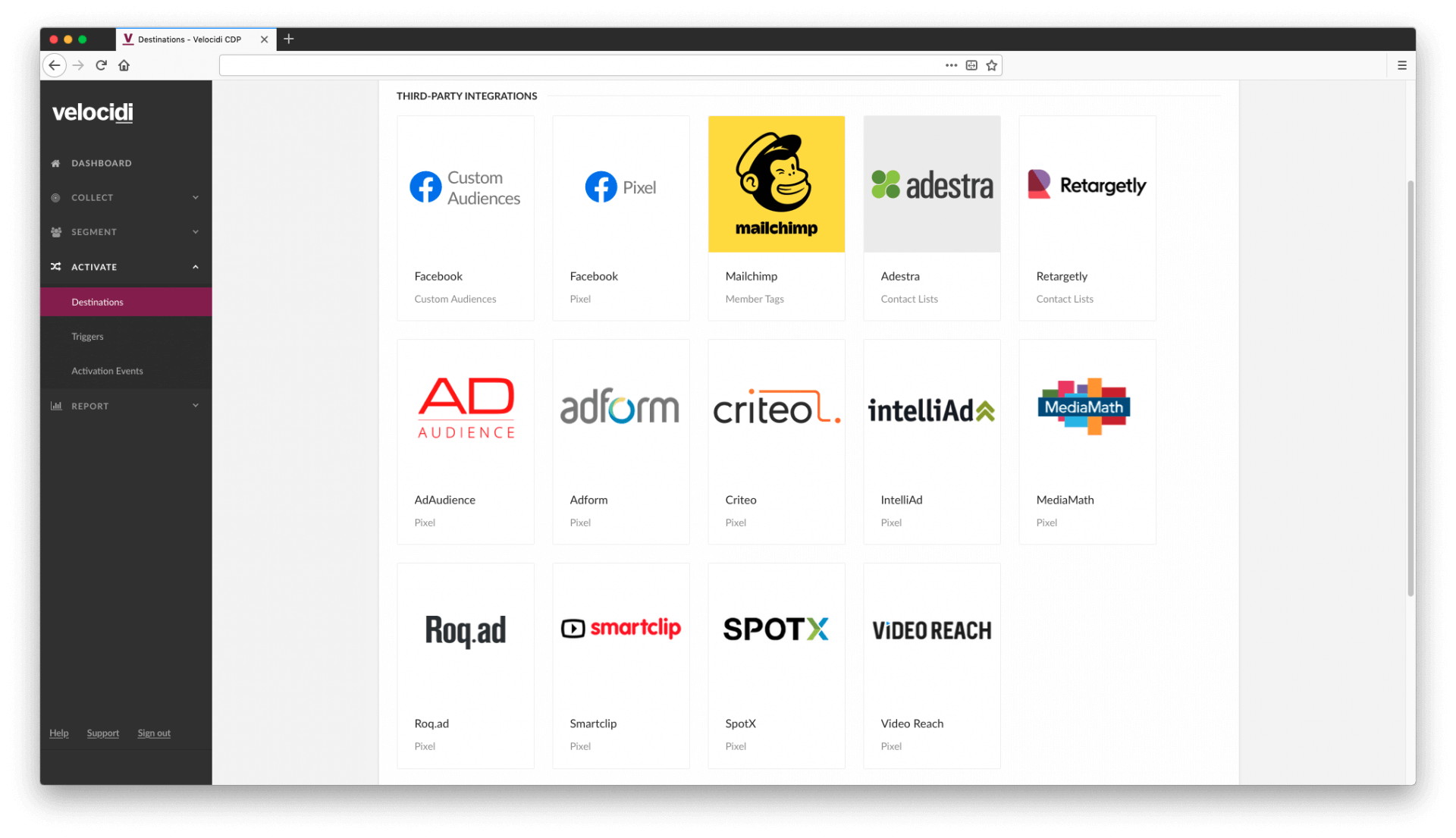
Google Analytics has been added as a custom destination enabling Velocidi to push segments directly to Google Analytics using a Gtag.
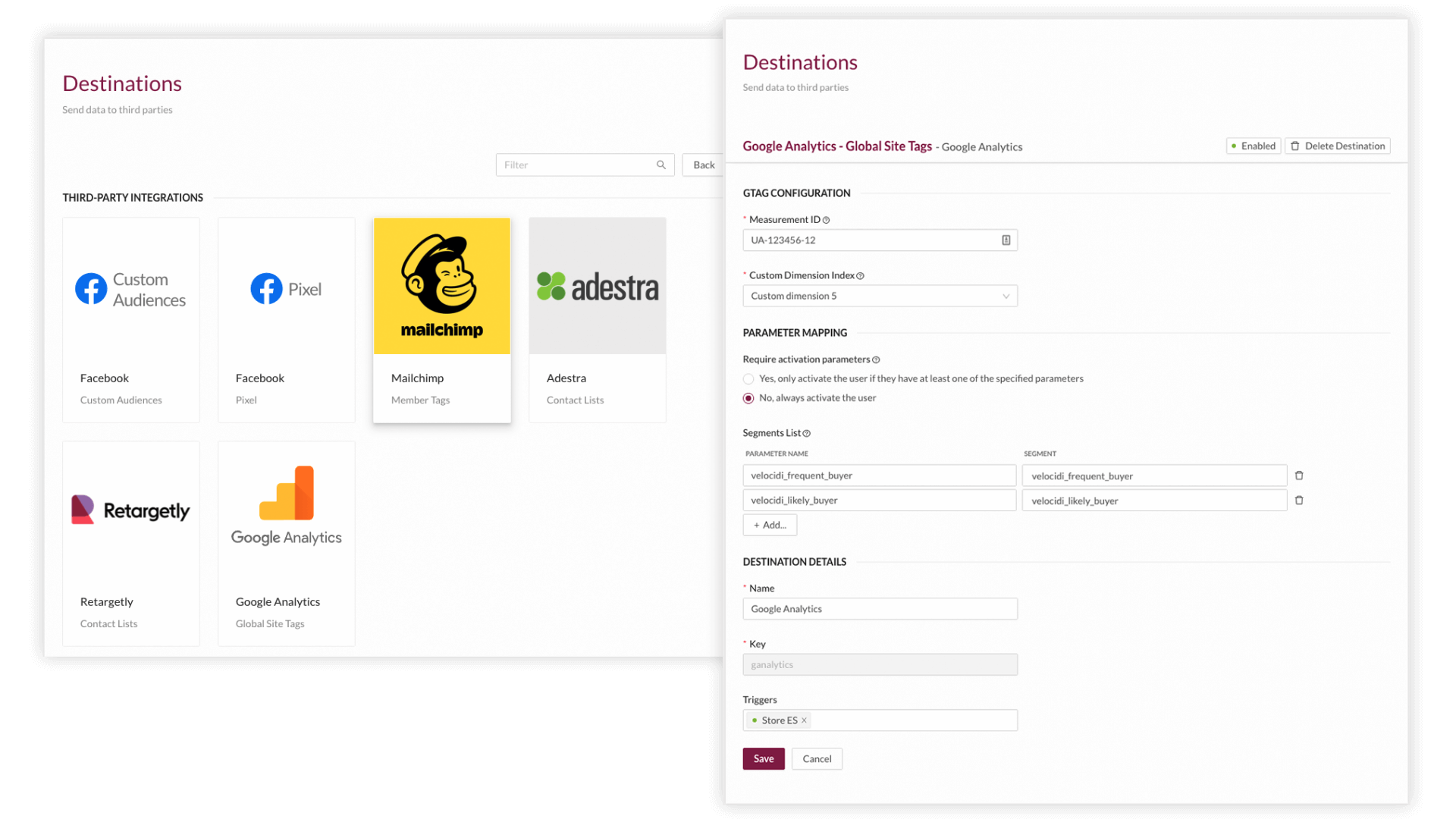
Pre-built default audiences have been added to the segments menu. Users can choose their favorite audiences to use on paid media marketing platforms from a catalog of use cases adapted to tackle different stages of the buyer's journey such as churn, prospecting, and retargeting.

Improvements
- Navigation and visibility of the events dashboard under the collection menu has been improved with the addition of a tab separating events Overview and All Events happening in real-time.
Release 20.8.0 – 2020-08-10
New
- appView Events - An appView event now takes the place of pageView events for views that take place on mobile apps.
- subscriptionDuration Attribute – When customers start a subscription, rather than a one-time order, the duration of the subscription will be recorded as an attribute.
Improvements
- Previously undefined attributes now have a default value of '0' – All attributes with event
counts are affected. In addition
purchaseTotalandpurchaseAvgwill default to 0 if the customer has not yet made a purchase. Andrefundwill default to 0 if no refund has bee issued to the customer.
Release 20.7.1 – 2020-07-27
New
Custom Events Appearing in the Main Dashboard and Events Stream – Custom tracking events now show up in the main dashboard as their own "Channel" to categorize them separately. They also show up labeled as "custom" in the events stream.
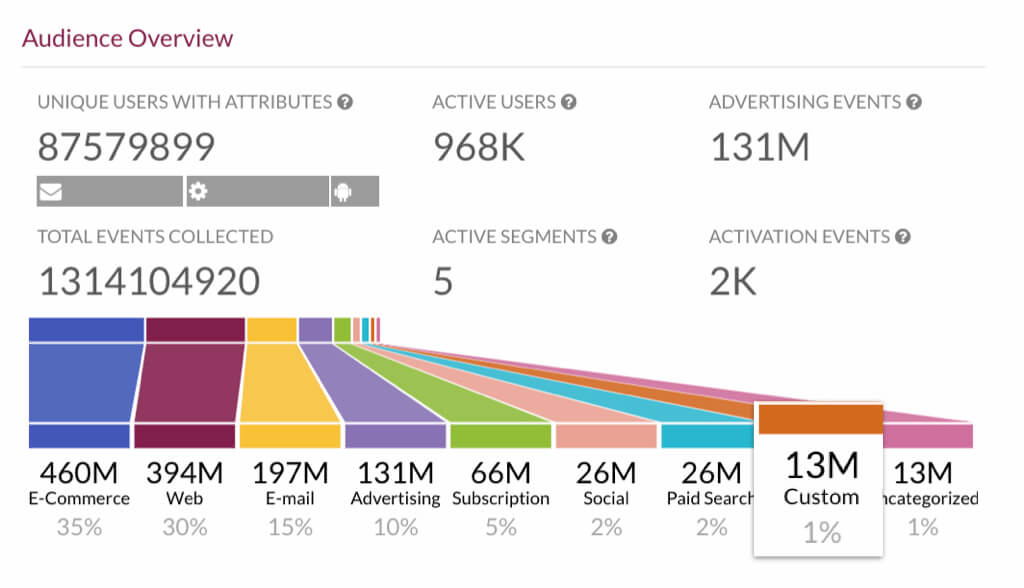
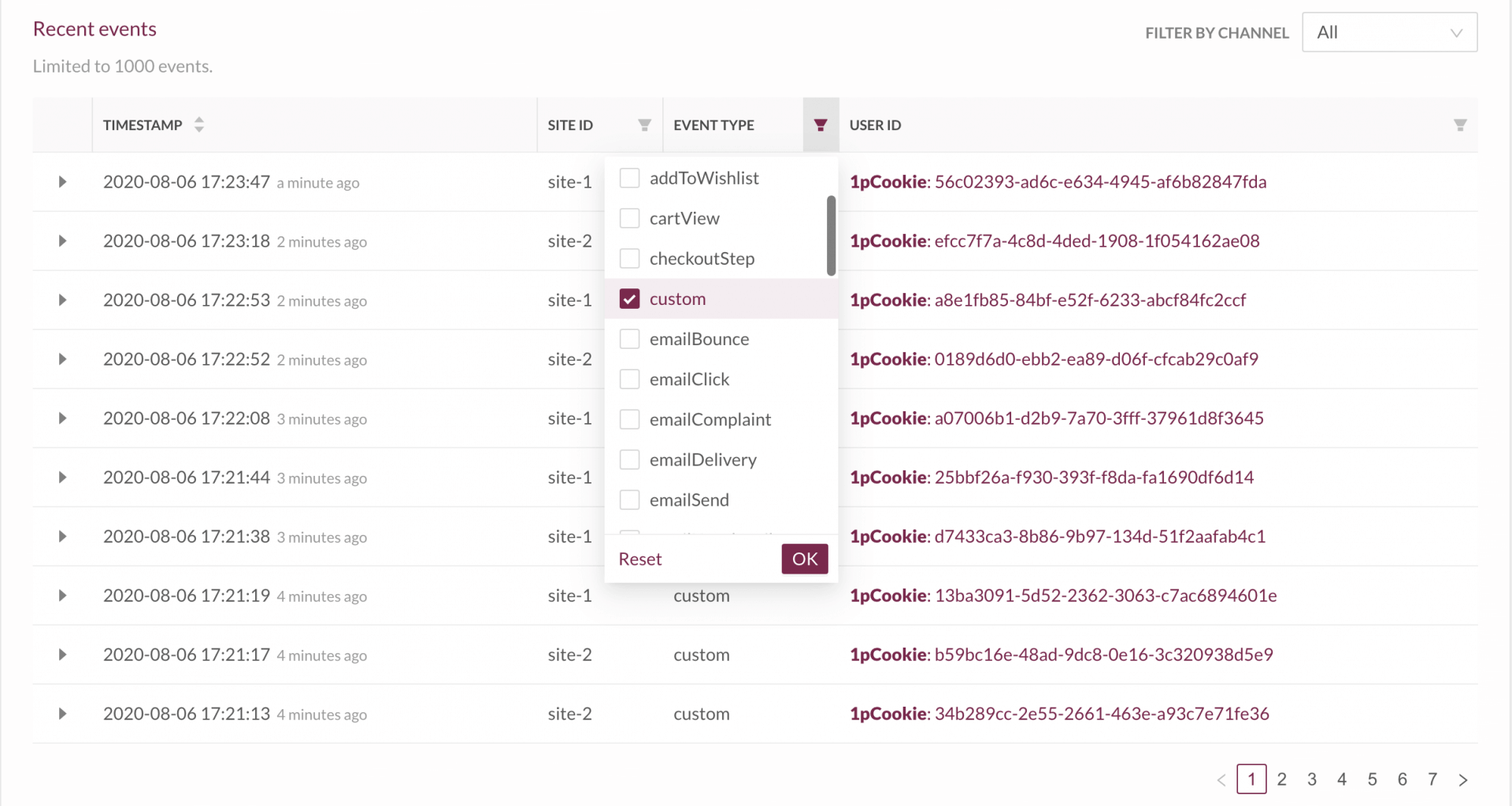
Release 20.7.0 – 2020-07-13
New
Tracking Custom Events – Velocidi clients are now able to track custom event types via the customer's detailed journey.

Improvements
- General improvements regarding how Next Purchase Predictions attributes are generated.
Release 20.6.2 – 2020-06-29
New
Default Segments – Velocidi clients will have access to a group of pre-defined audience segments created from RFM percentiles and predictive attributes. They will include segments of most loyal customers, customers at risk of churning, high spending new customers, and more. Default segments will not be editable, but they will be maintained and improved by the Velocidi product team. Users can create modified versions of default segments by cloning them.
Segments can now be assigned categories – In order to better organize audience segments, a "Category" field has been added to the segment builder. Users can create whatever categories they like. The categories can then be used to sort and filter the segments list view. Default segments will be categorized with a "Velocidi" label.

Improvements
- Form values will no longer reset if 'submit' fails.
- Fixed a bug causing charts to render incorrectly in Firefox.
Release 20.6.1 – 2020-06-15
New
Support for scheduling offline data imports – The CDP users are now able to import offline product and user data on a schedule with a UI that provides streamlined user experience. Velocidi clients have deep control over data imports and all aspects that have to do with managing scheduled imports of customer data and product data.
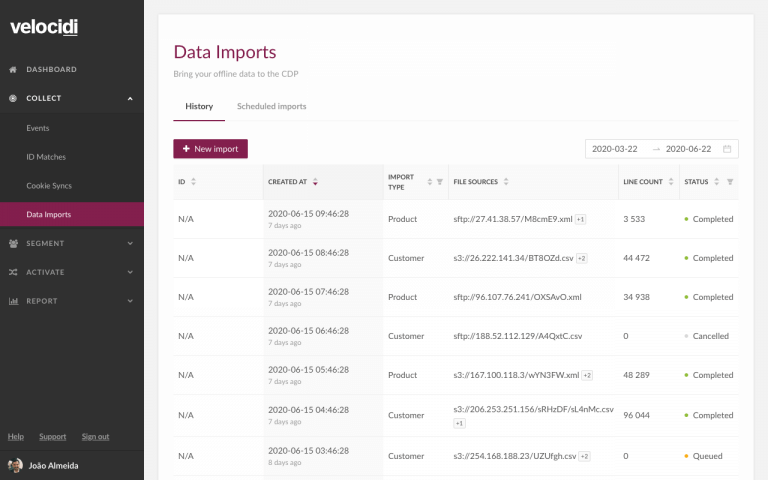
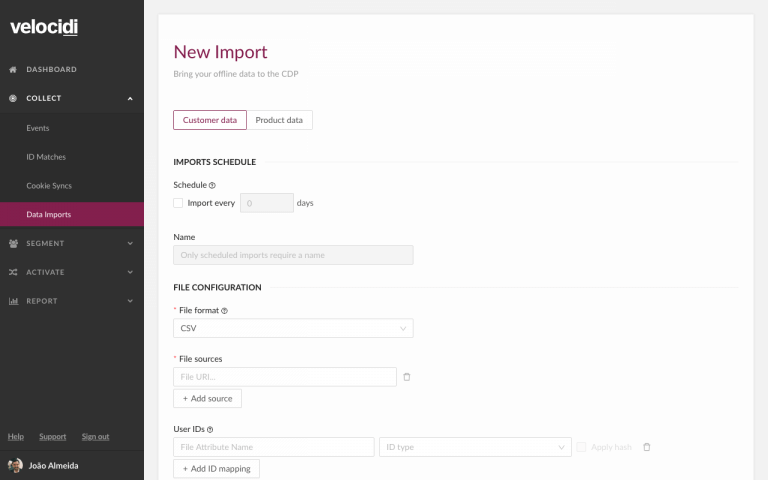
Revamped inline segment chart helpers – We've changed the way segment chart helpers are displayed by removing pop-up modal windows. All charts now appear inline contributing to an intuitive and uncluttered experience providing valuable information while creating segments.
Improvements
The latest event tables filters now show all possible Destinations/MatchProviders/Cookiesyncs as filters.

Likelihood to buy helper's graph and metrics have been improved and made more perceptible.
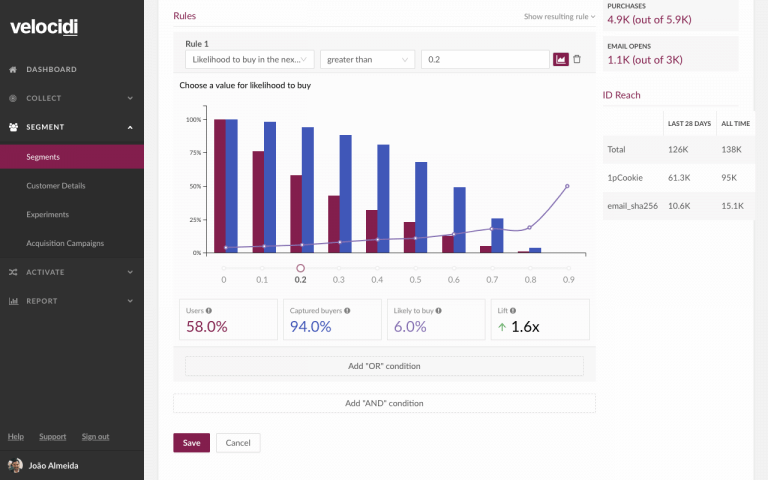
Minor bugfix and improvements.
Release 20.6.0 – 2020-06-01
New
New setup wizard for Destinations – The creation process for new destinations has been changed to a step-by-step wizard for better user experience.
Detailed events for order activity added to the e-commerce category of events – You will now see additional events in customer journeys and elsewhere that capture customer actions during the ordering process such as order fulfill, order update, order refund, and order cancel.
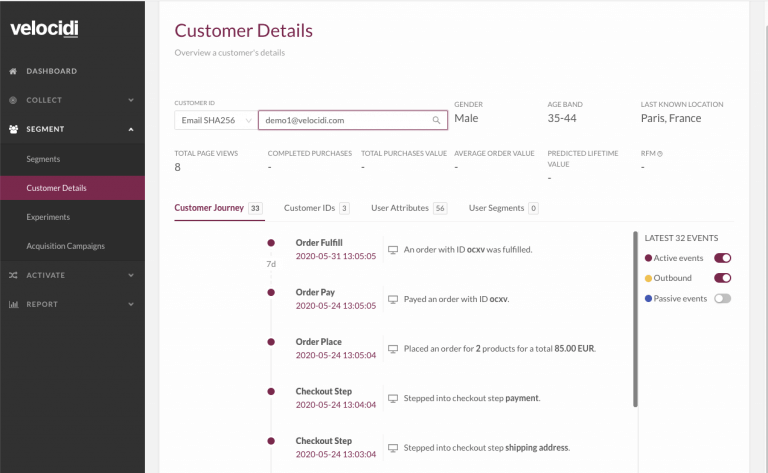
An Activation Details tab has been added to Activation Events, showing the attributes and segment parameters of the activation as well as the payload used in the activation.
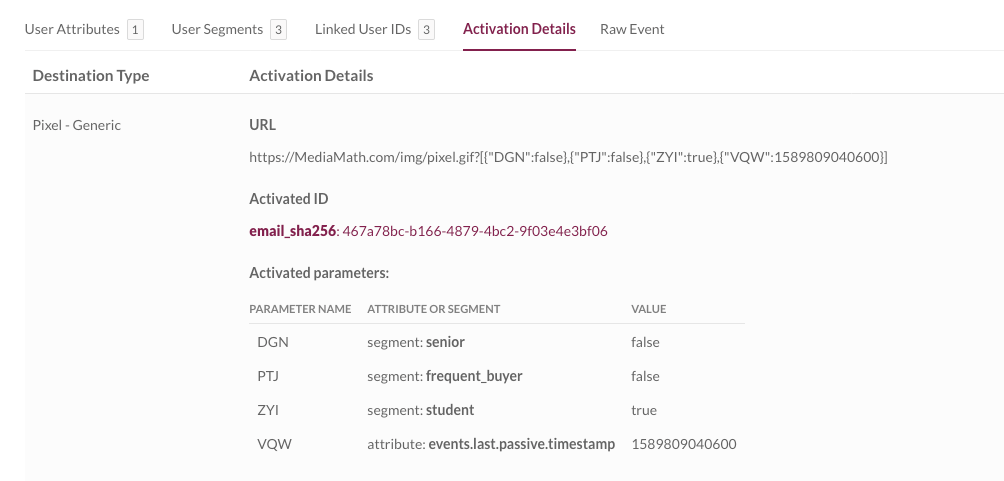
Improvements
- Fixed a bug causing attributes to appear in place of categories when building segments with next purchase predictions.
Release 20.5.1 – 2020-05-18
New
We've added support for associating Triggers to specific Destinations directly from the destinations menu. This allows for a more streamlined customer experience when setting up your activations.
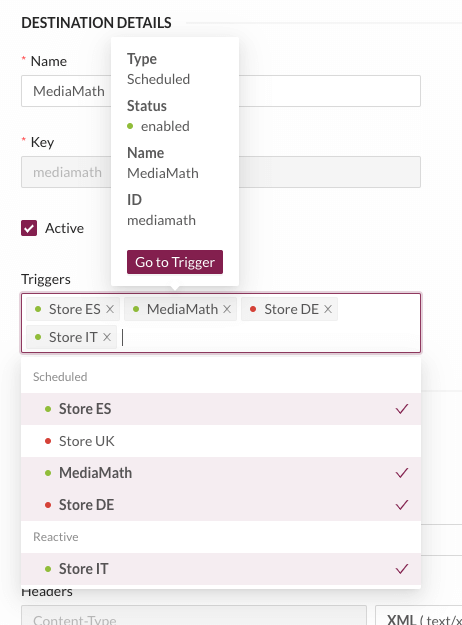
User can now set optional duration thresholds in the Scheduled Trigger menu. This feature offers more control over our client's preferred rules of engagement for users who have been recently active or inactive for any given amount of days.
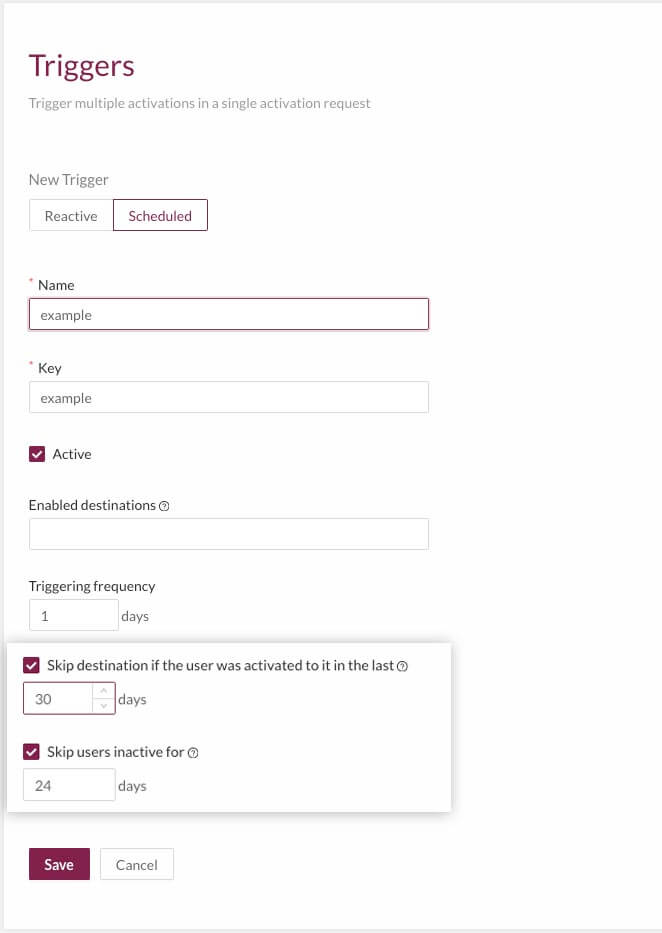
Events such as cartView and checkoutStep are now supported and can be visible on the Collect > Events overview and on Customer Details view as depicted.
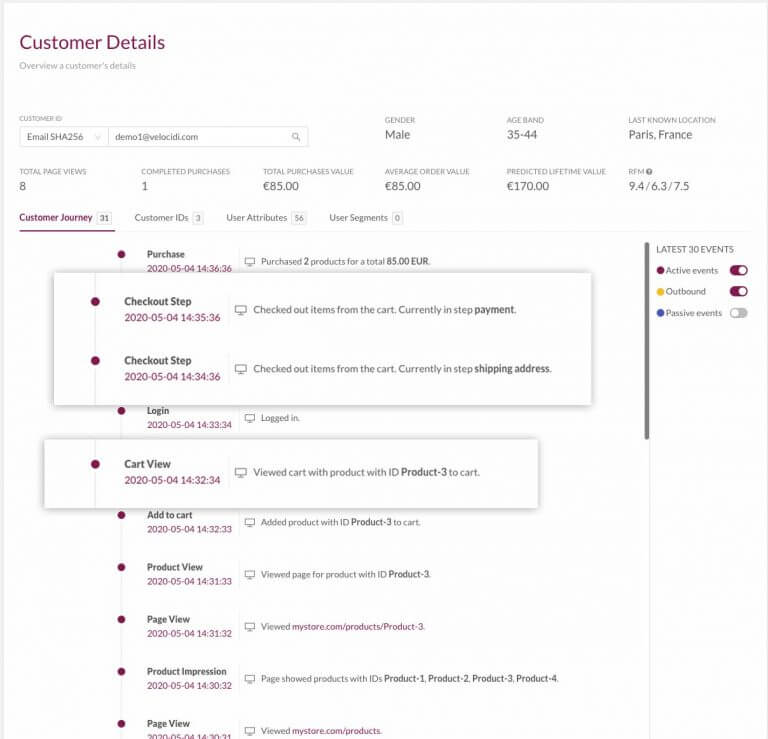
Improvements
- Updates and tweaks to the GUI of the product including the creation of new default style for vertical forms and converting all forms to a vertical layout.
Release 20.5.0 – 2020-05-04
New
RFM (Recency, Frequency, Monetary Value) percentiles are now included in customer profiles and available as attributes for segmentation. The percentile-based classification assigns a score from 0-10 on how the customer compares with other customers in the platform. A user must have made a purchase to have an RFM classification.
- Recency: How recently did they purchase? More recent purchases contribute to a higher R score
- Frequency: How often do they purchase? More frequent purchases contribute to a higher F score
- Monetary Value: How much do they spend? More money spent contributes to a higher M score
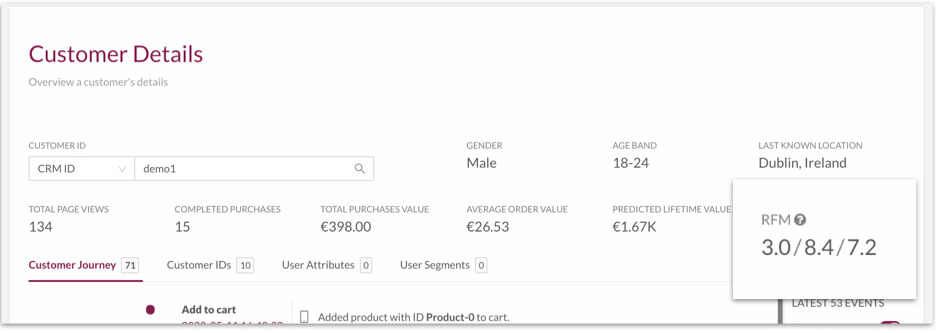
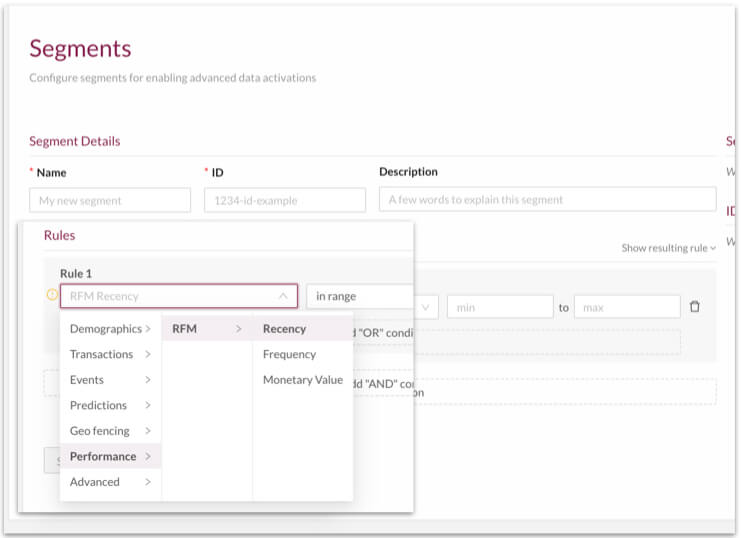
Improvements
Operators for dynamic time segments, specifically for the next purchase timestamp attributes, have been renamed for clarification.
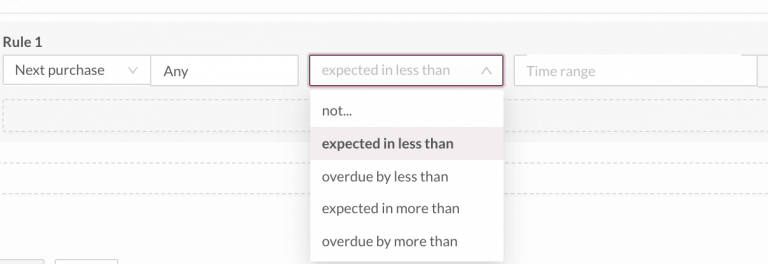
The setup process for the Facebook Custom Audiences destination has been improved to eliminate unnecessary complexity.
The training interval for the next purchase predictions has been increased to 98 days.
Release 20.4.1 – 2020-04-20
In this release, our team focused mainly on improving aspects of product infrastructure stability, as well as improving details of navigation usability.
New
Date Ranges on Attribution Reports – Report creating now identifies days for which attribution data is available for generating reports. This prevents the users from creating reports with invalid data contained in certain date-ranges.
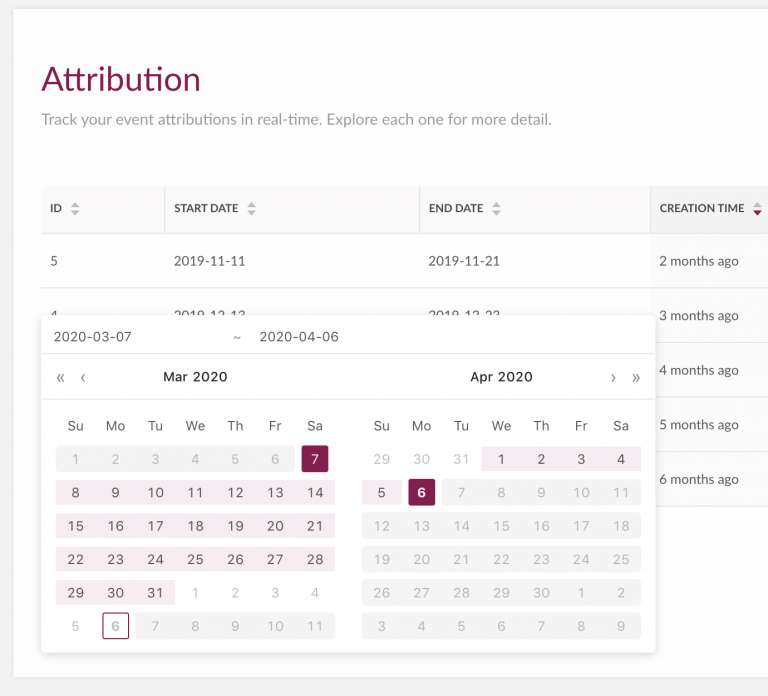
Improvements
The contextual helper text on segmentation rule for email predictions now clarified that it relates to users and not probabilities.
Update default order on the dynamic segment dropdown for Next Purchase predictions.

Uniformize the representation of the date and time formats to ISO 8601.
Release 20.4.0 – 2020-04-06
New
Email Predictions added to segment builder – Velocidi clients can now use the segment builder to create segments based on predicted email behavior such as user likelihood to click, open, or unsubscribe. These segments will be used in activations with email providers like Mailchimp. Marketers can use them to optimize email delivery in campaigns, finding an ideal time and frequency of emails for each customer.

Next Purchase Date added to segment builder – Velocidi clients can now segment users according to when they are likely to make their next purchase. This includes customers who are likely to make a purchase in the near future, and customers who are overdue for a purchase. These rules can be specific to product categories or for any purchase of any category. And they remain dynamic, reflecting predictions based on each customer's event history.

Improvements
It is now possible to preview the rule generated by the segment builder. It is collapsed by default.

Columns in attribution reports are now sortable and filterable.
Release 20.3.1 – 2020-03-23
New
Retargetly integration – Velocidi now offers direct integration with Retargetly via direct SFTP file drop. This features removes the hassle of having to create bespoke file formats and allows marketers to easily activate segments on Retargetly.
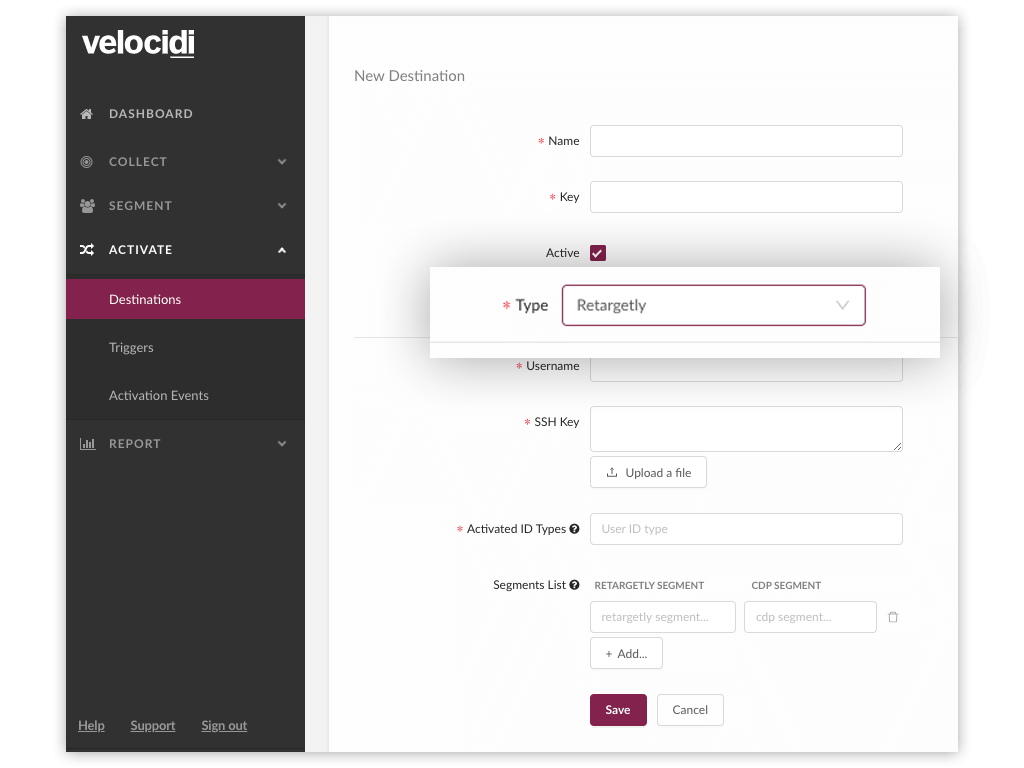
User attributes for Next Purchase Predictions and RFM – These attributes have been added to customer details to allow Velocidi's machine learning to draw predictions based on their next purchase behavior and feed our models based on the RFM (recency, frequency, monetary value) analysis.

Customer's CLV in Attribution Reports – A new column displaying new customer lifetime value per channel has been added to the Attribution Reports providing immediate insights into the value of each channel, which can lead to key decisions regarding marketing investment per channel.
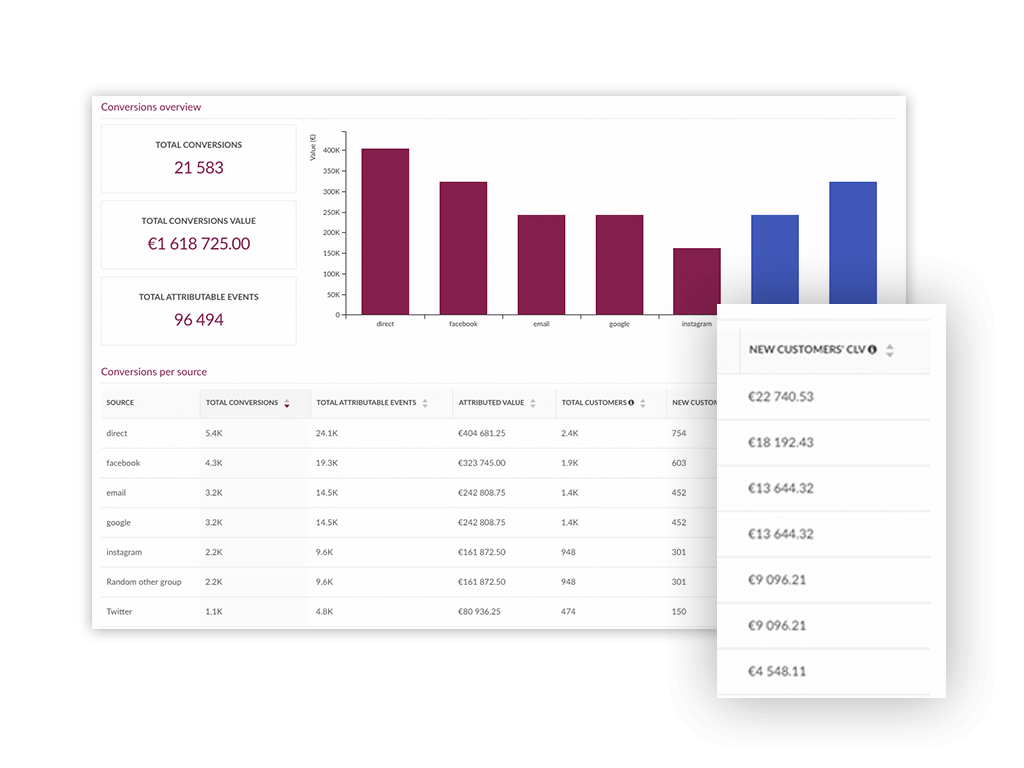
Improvements
- Updated login and discount structure on tracking event – We have updated the way we capture events, namely those concerning logins, discounts and all the events evolving prices. For further information, please refer to our updated documentation.
Release 20.3.0 – 2020-03-09
New
Integration wizard for Facebook Custom Audiences – Velocidi can now activate email and device IDs to Facebook Custom Audiences using a server-to-server connection. This feature is useful to marketers creating segments to re-engage dormant clients who haven't visited the site in a while to improve retention rates.
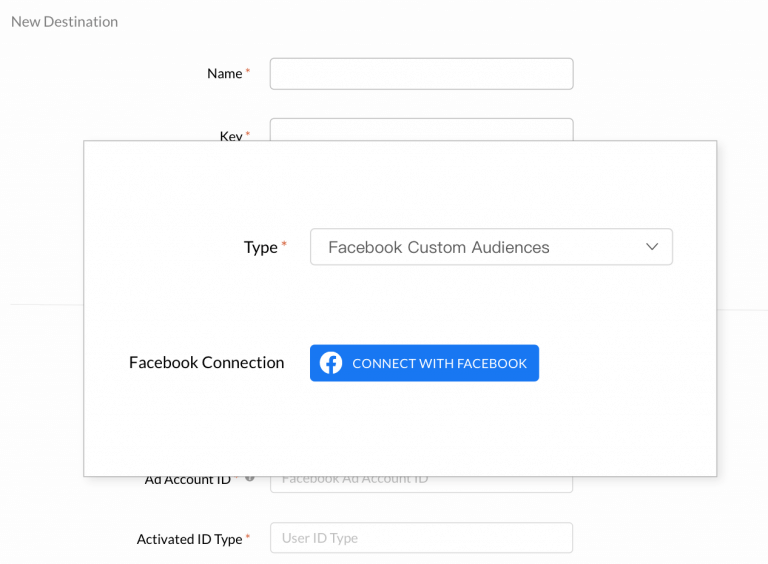
Scheduled triggers are now available in Activations – Clients now have a choice of 'reactive' and 'scheduled' triggers. Reactive triggers will activate customers in real time as before, and scheduled triggers can be used when you want to activate groups of people in batches at pre-determined intervals.
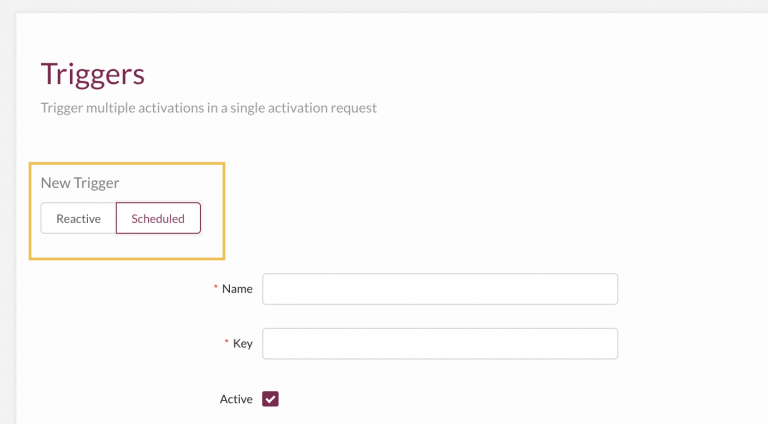
Event error notifications now come with a description detailing the issue to help expedite debugging.

Improvements
- Increased the default date range in attribution reports from 28 days to 90 days, in order to better align with best practices regarding conversion 'look-back windows' in e-commerce sales cycles.
Release 20.02.1 – 2020-02-24
Changes & Fixes
Attribution Reports now displays two columns for the number of total customers and new customers per dimension.

Added TSV (tabs separated value) file support on File Drop Activations. Upon configuring new activation destinations of the file drop type, users can now select between the CSV or TSV formats.

As legacy file drop is bein dropped in favor of the aforementioned methods, we have duly updated our documentation.
Release 20.02.0 – 2020-02-10
Changes & Fixes
- Insights/Prospecting campaigns are renamed and relocated to Segment/Acquisition Campaign Recommendations.
- Acquisition Campaign Recommendations now displays an estimation of potential lift in place of the previous performance metric.
- Added "expand date frame" suggestion button when a time-filtered search returns no results.
- Dashboard overhaul: the font has been changed to Lato plus multiple minor fixes.
- Started using semantic nomenclatures for date/time operators in the segment builder for a more pleasant user experience.
Release 20.01.0 – 2020-01-27
Changes & Fixes
- Improvements to the UI/UX of Next Purchase Date when creating a segment for the next purchase timestamp.
- Improvements to the Prospecting Campaigns Model and Prospecting Campaigns dashboard.
- Further enhancements have been made to third-party cookies sync requests.
Release 19.12.2 – 2020-01-13
Changes & Fixes
This release includes multiple updates improving system performance.
- Customer-facing changes & fixes include:
- emailsends are now categorized as outbound event types
- Conversion lists on the Attribution Report now display a note referring to the number of events displayed.
- The "event type filter" on "recent events table" now displays all available event types, independently from the chosen time-frame.